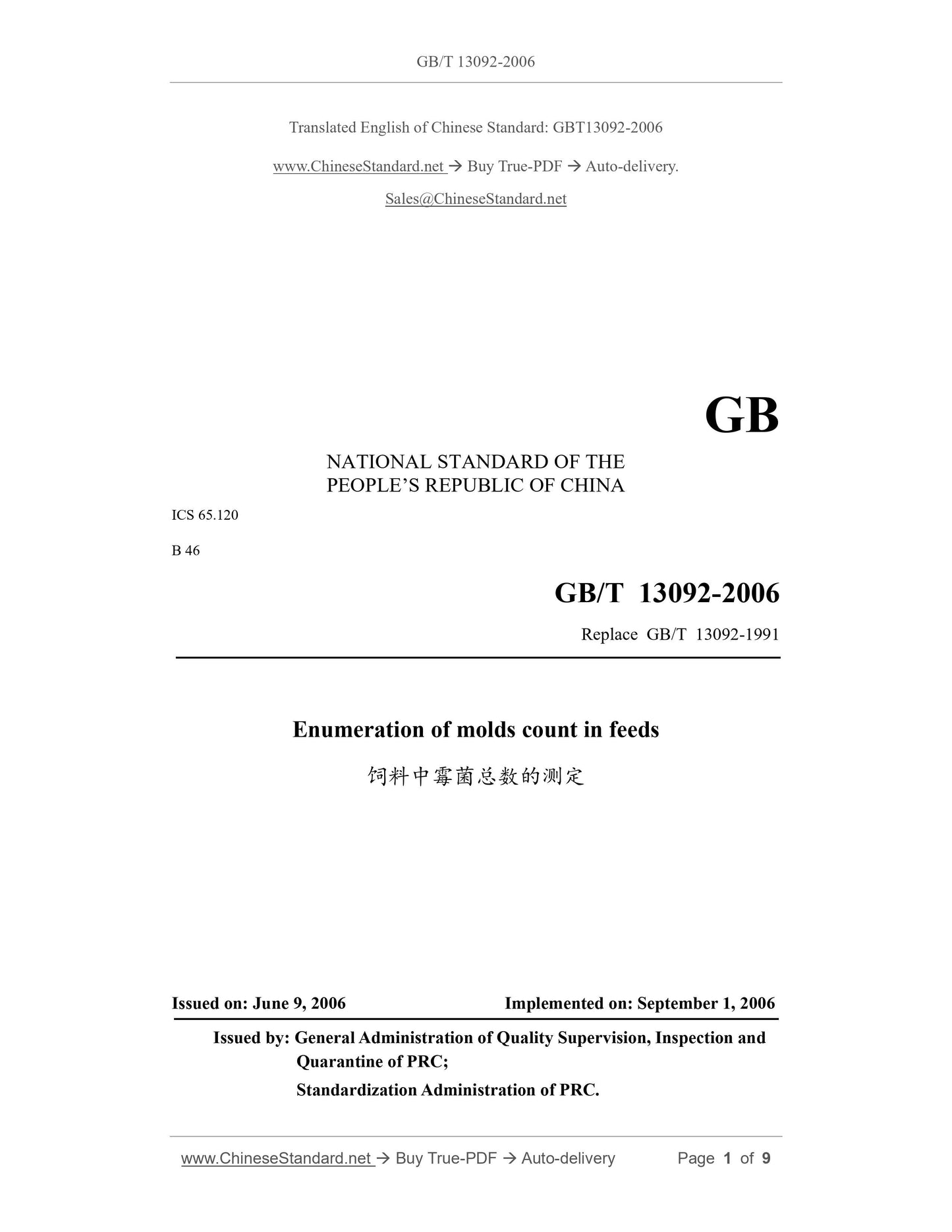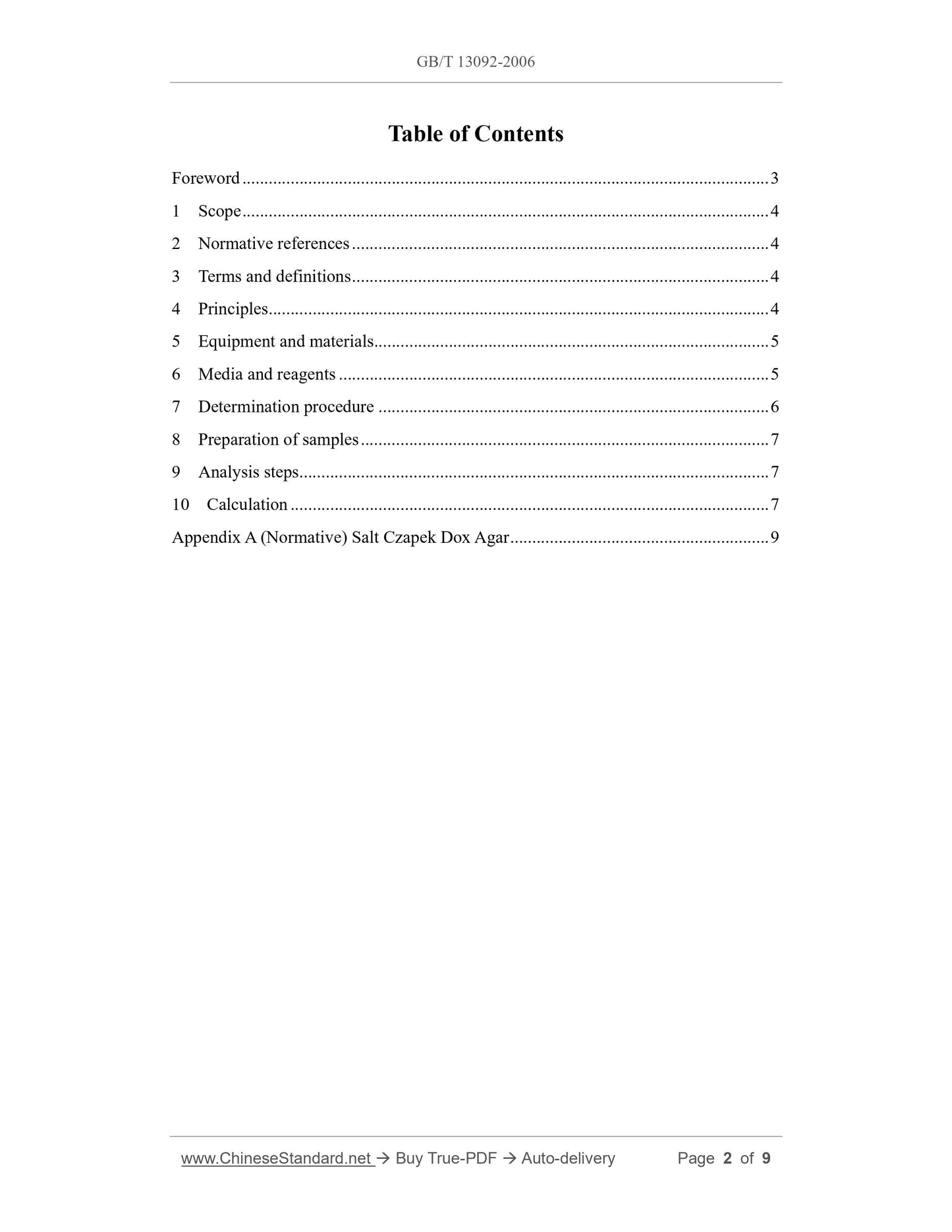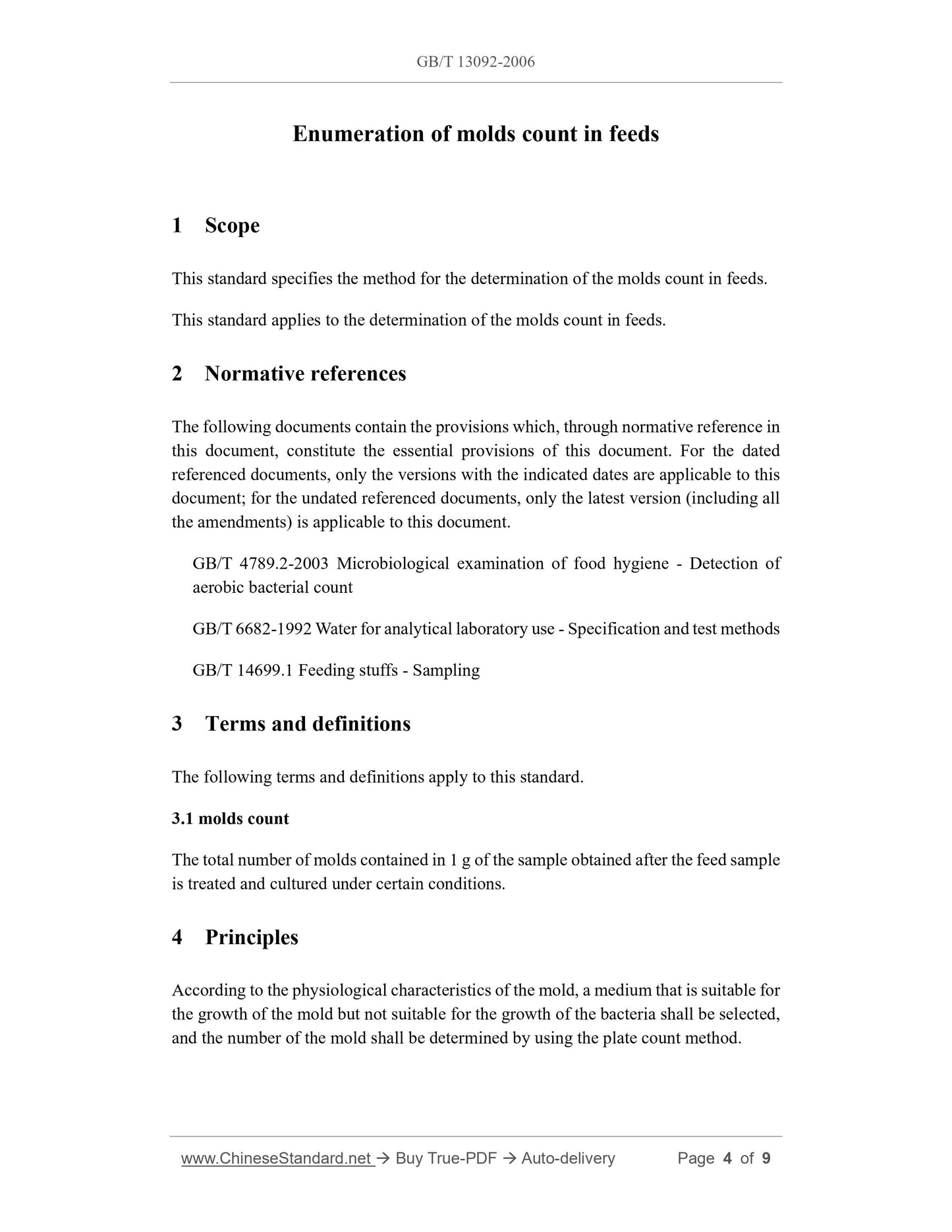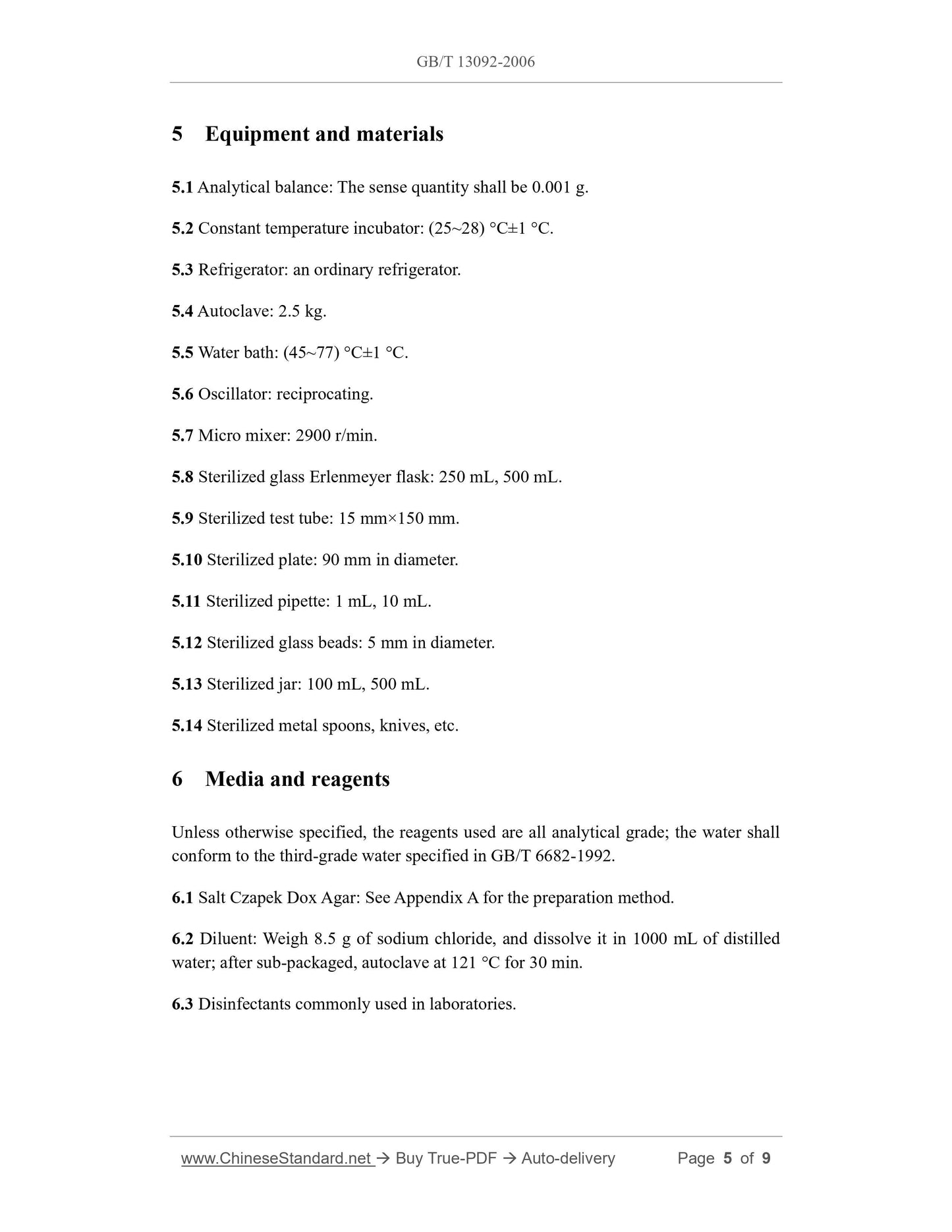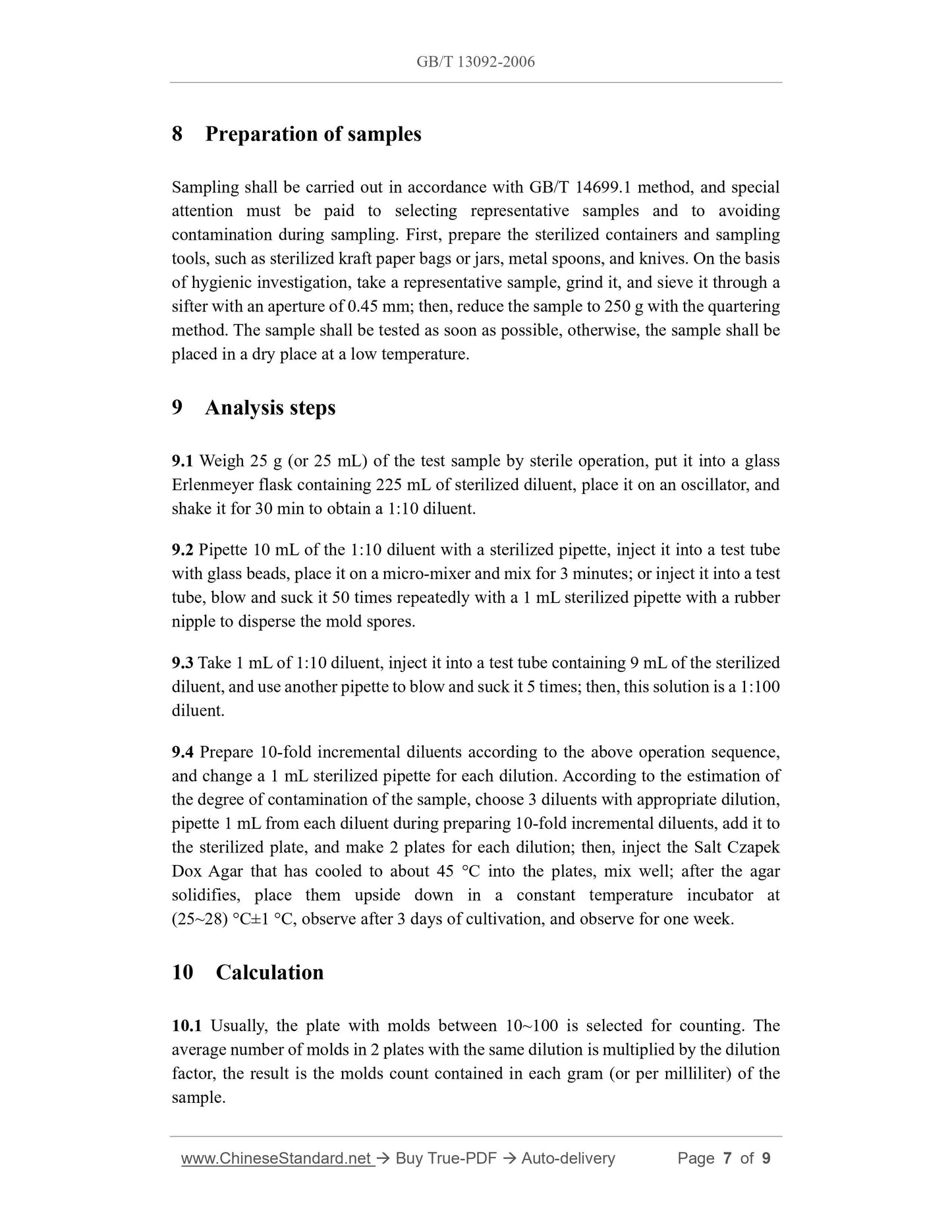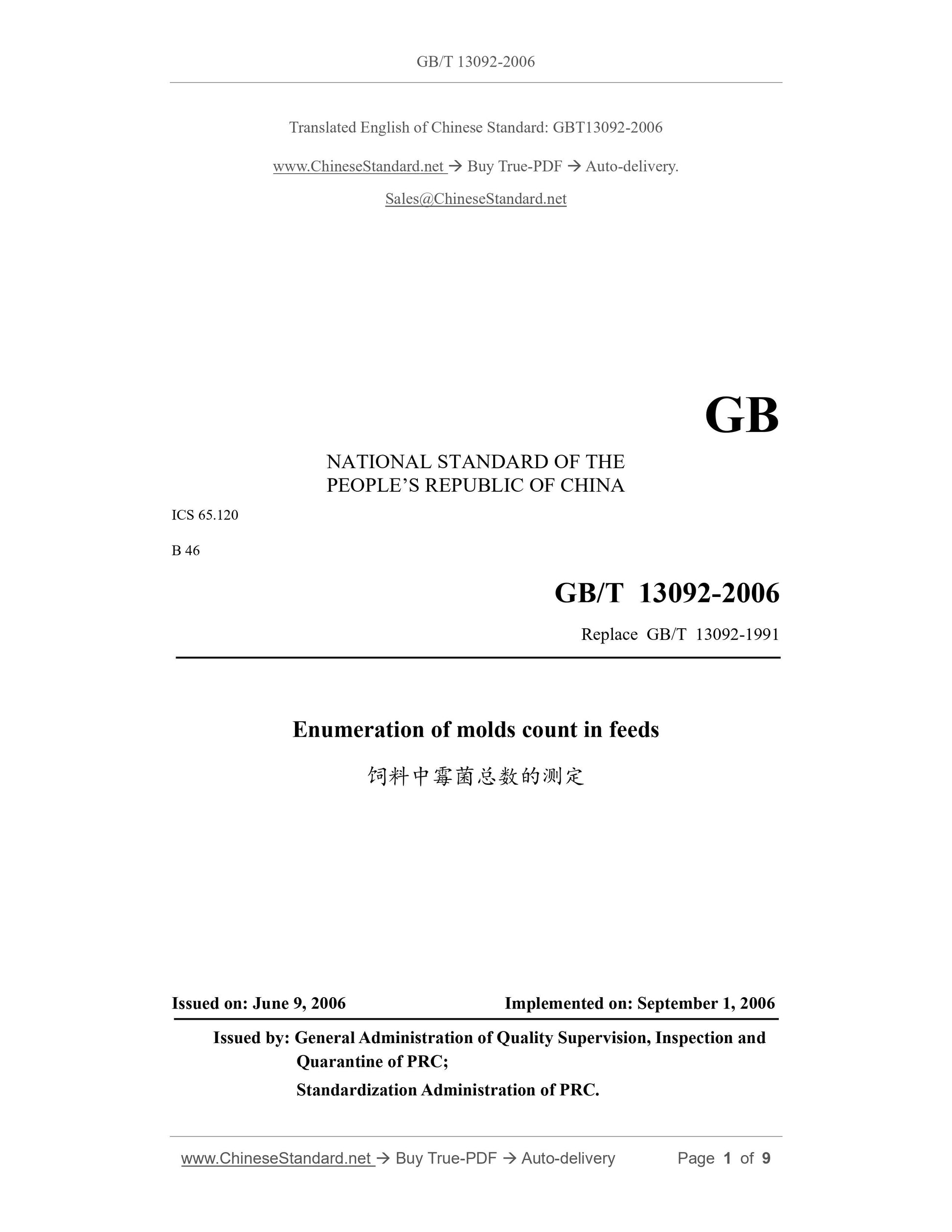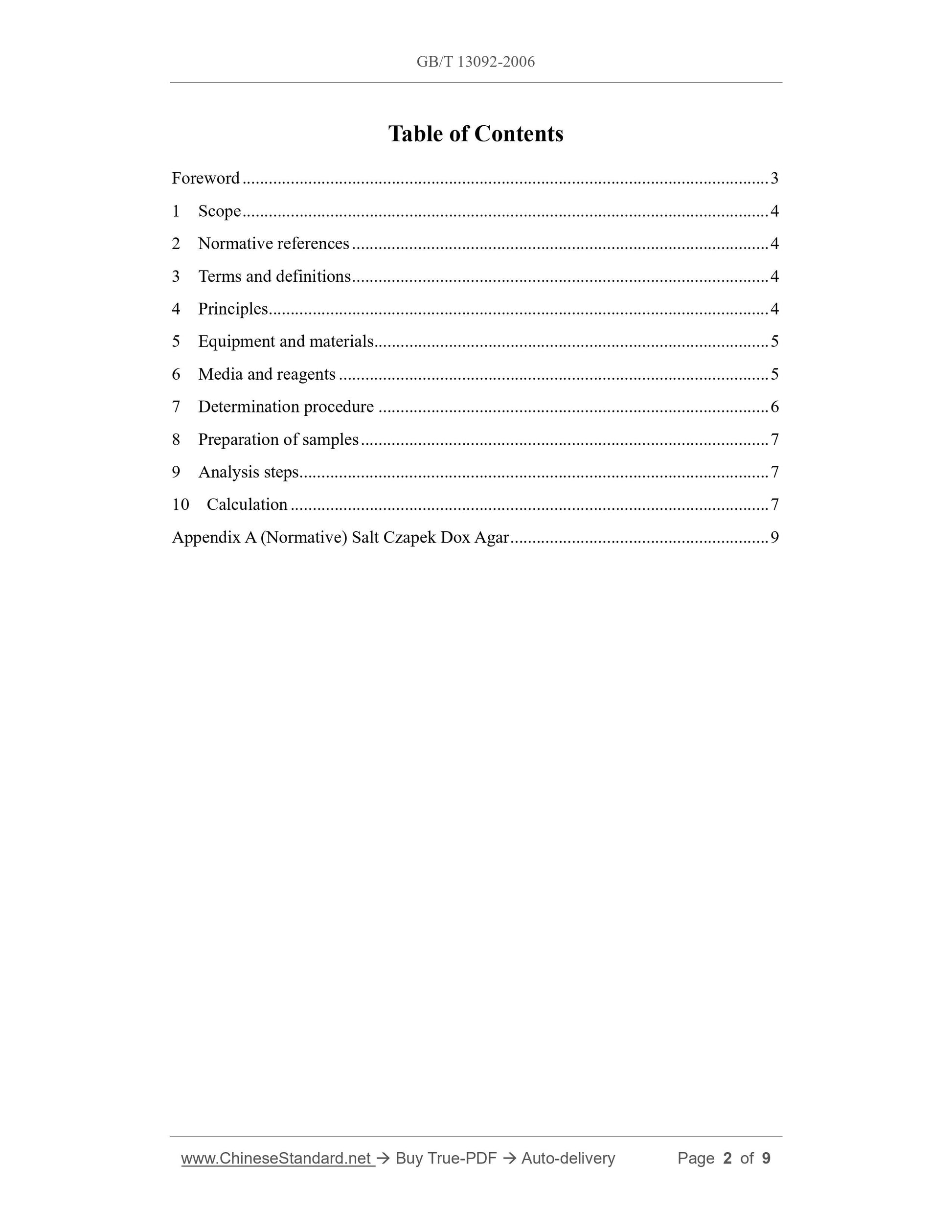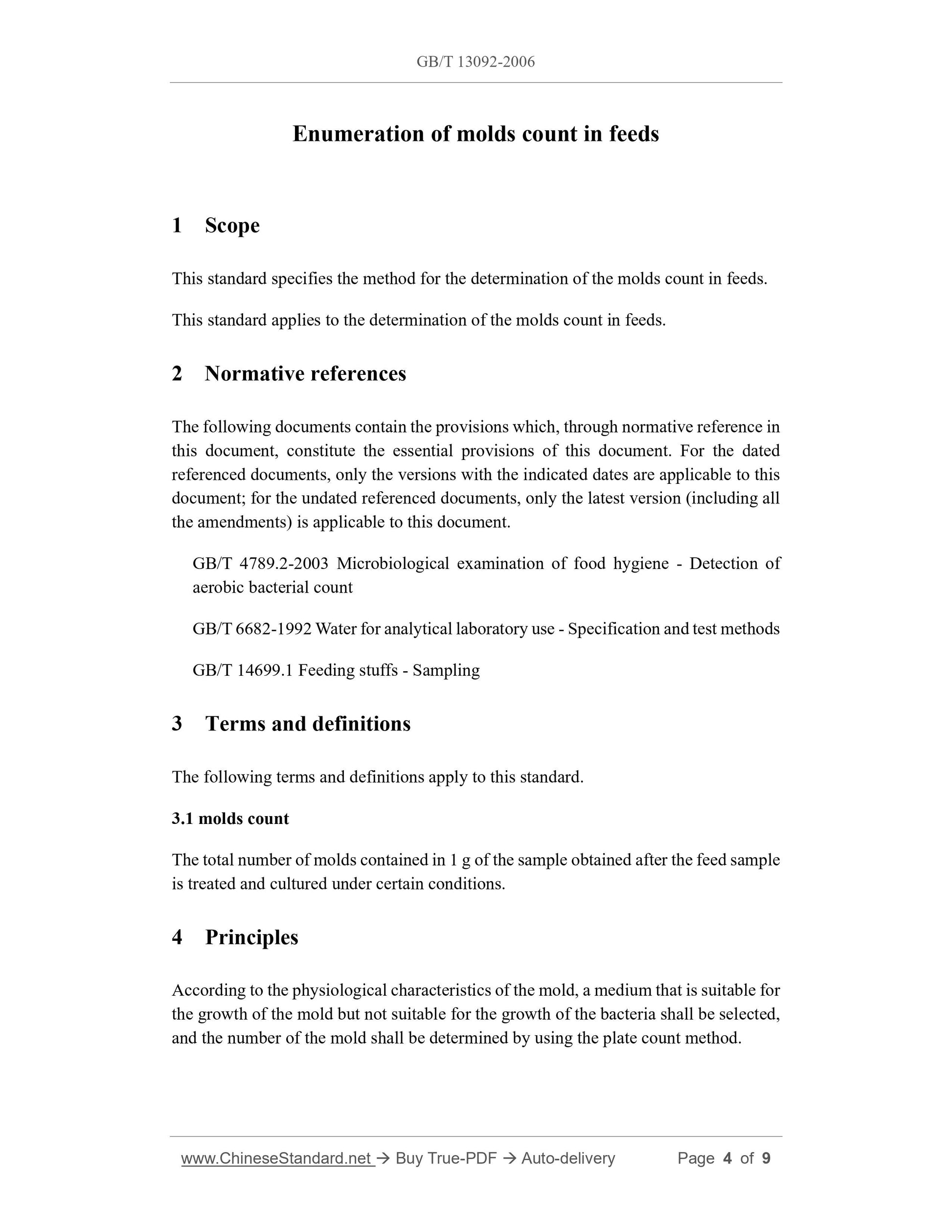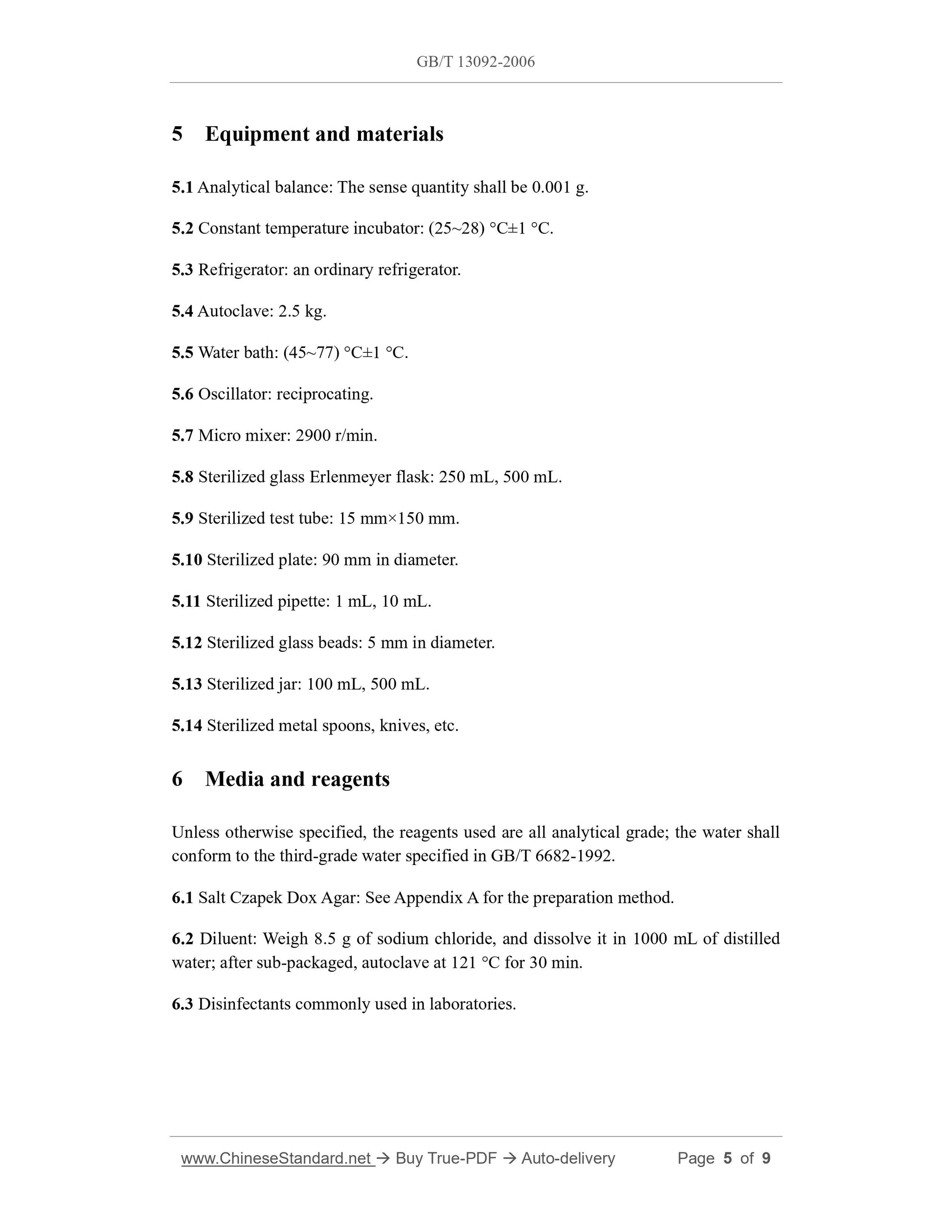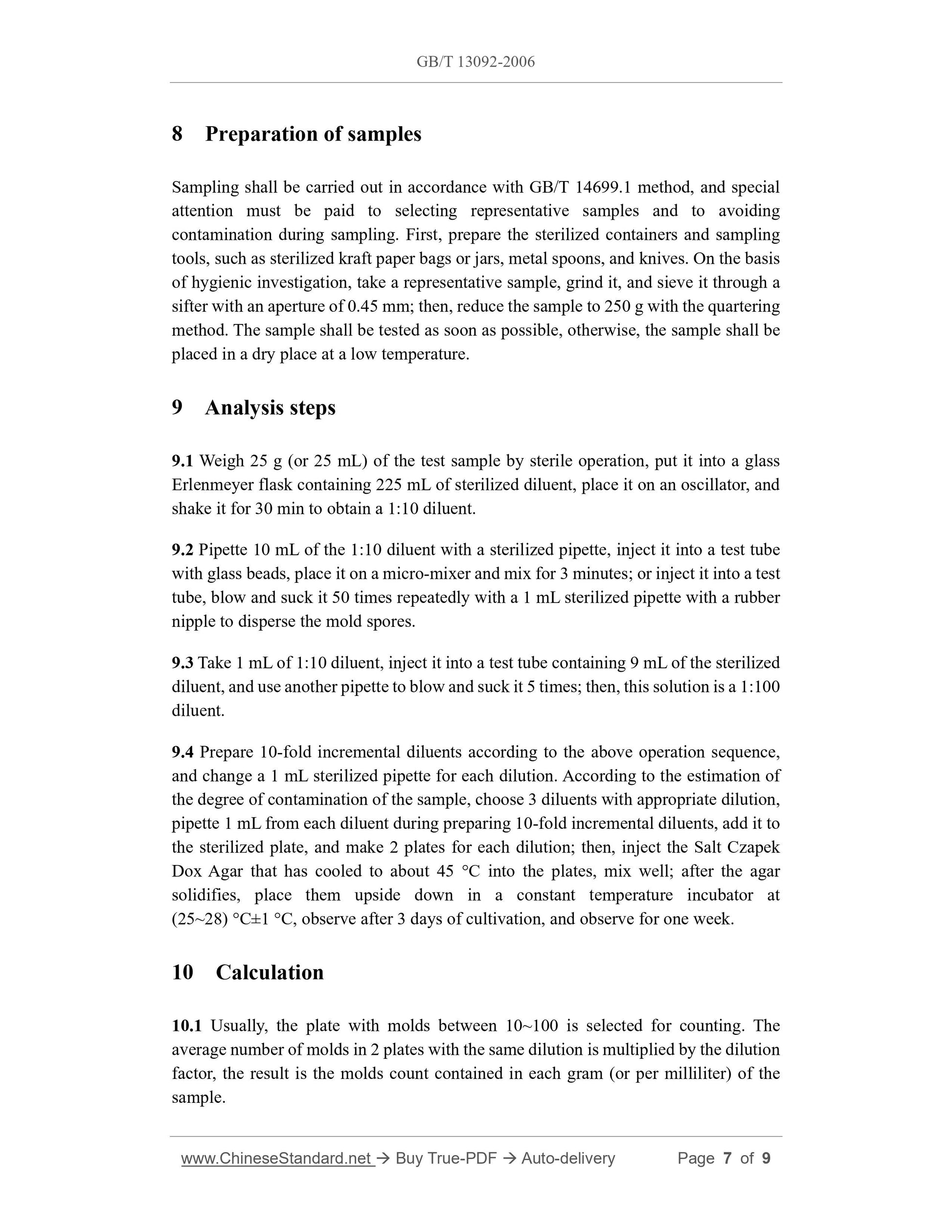1
/
of
5
www.ChineseStandard.us -- Field Test Asia Pte. Ltd.
GB/T 13092-2006 English PDF (GB/T13092-2006)
GB/T 13092-2006 English PDF (GB/T13092-2006)
Regular price
$150.00
Regular price
Sale price
$150.00
Unit price
/
per
Shipping calculated at checkout.
Couldn't load pickup availability
GB/T 13092-2006: Enumeration of molds count in feeds
Delivery: 9 seconds. Download (& Email) true-PDF + Invoice.
Get Quotation: Click GB/T 13092-2006 (Self-service in 1-minute)
Historical versions (Master-website): GB/T 13092-2006
Preview True-PDF (Reload/Scroll-down if blank)
GB/T 13092-2006
GB
NATIONAL STANDARD OF THE
PEOPLE’S REPUBLIC OF CHINA
ICS 65.120
B 46
Replace GB/T 13092-1991
Enumeration of molds count in feeds
ISSUED ON: JUNE 9, 2006
IMPLEMENTED ON: SEPTEMBER 1, 2006
Issued by: General Administration of Quality Supervision, Inspection and
Quarantine of PRC;
Standardization Administration of PRC.
Table of Contents
Foreword ... 3
1 Scope ... 4
2 Normative references ... 4
3 Terms and definitions ... 4
4 Principles ... 4
5 Equipment and materials ... 5
6 Media and reagents ... 5
7 Determination procedure ... 6
8 Preparation of samples ... 7
9 Analysis steps ... 7
10 Calculation ... 7
Appendix A (Normative) Salt Czapek Dox Agar ... 9
Enumeration of molds count in feeds
1 Scope
This standard specifies the method for the determination of the molds count in feeds.
This standard applies to the determination of the molds count in feeds.
2 Normative references
The following documents contain the provisions which, through normative reference in
this document, constitute the essential provisions of this document. For the dated
referenced documents, only the versions with the indicated dates are applicable to this
document; for the undated referenced documents, only the latest version (including all
the amendments) is applicable to this document.
GB/T 4789.2-2003 Microbiological examination of food hygiene - Detection of
aerobic bacterial count
GB/T 6682-1992 Water for analytical laboratory use - Specification and test methods
GB/T 14699.1 Feeding stuffs - Sampling
3 Terms and definitions
The following terms and definitions apply to this standard.
3.1 molds count
The total number of molds contained in 1 g of the sample obtained after the feed sample
is treated and cultured under certain conditions.
4 Principles
According to the physiological characteristics of the mold, a medium that is suitable for
the growth of the mold but not suitable for the growth of the bacteria shall be selected,
and the number of the mold shall be determined by using the plate count method.
5 Equipment and materials
5.1 Analytical balance: The sense quantity shall be 0.001 g.
5.2 Constant temperature incubator: (25~28) °C±1 °C.
5.3 Refrigerator: an ordinary refrigerator.
5.4 Autoclave: 2.5 kg.
5.5 Water bath: (45~77) °C±1 °C.
5.6 Oscillator: reciprocating.
5.7 Micro mixer: 2900 r/min.
5.8 Sterilized glass Erlenmeyer flask: 250 mL, 500 mL.
5.9 Sterilized test tube: 15 mm×150 mm.
5.10 Sterilized plate: 90 mm in diameter.
5.11 Sterilized pipette: 1 mL, 10 mL.
5.12 Sterilized glass beads: 5 mm in diameter.
5.13 Sterilized jar: 100 mL, 500 mL.
5.14 Sterilized metal spoons, knives, etc.
6 Media and reagents
Unless otherwise specified, the reagents used are all analytical grade; the water shall
conform to the third-grade water specified in GB/T 6682-1992.
6.1 Salt Czapek Dox Agar: See Appendix A for the preparation method.
6.2 Diluent: Weigh 8.5 g of sodium chloride, and dissolve it in 1000 mL of distilled
water; after sub-packaged, autoclave at 121 °C for 30 min.
6.3 Disinfectants commonly used in laboratories.
8 Preparation of samples
Sampling shall be carried out in accordance with GB/T 14699.1 method, and special
attention must be paid to selecting representative samples and to avoiding
contamination during sampling. First, prepare the sterilized containers and sampling
tools, such as sterilized kraft paper bags or jars, metal spoons, and knives. On the basis
of hygienic investigation, take a representative sample, grind it, and sieve it through a
sifter with an aperture of 0.45 mm; then, reduce the sample to 250 g with the quartering
method. The sample shall be tested as soon as possible, otherwise, the sample shall be
placed in a dry place at a low temperature.
9 Analysis steps
9.1 Weigh 25 g (or 25 mL) of the test sample by sterile operation, put it into a glass
Erlenmeyer flask containing 225 mL of sterilized diluent, place it on an oscillator, and
shake it for 30 min to obtain a 1:10 diluent.
9.2 Pipette 10 mL of the 1:10 diluent with a sterilized pipette, inject it into a test tube
with glass beads, place it on a micro-mixer and mix for 3 minutes; or inject it into a test
tube, blow and suck it 50 times repeatedly with a 1 mL sterilized pipette with a rubber
nipple to disperse the mold spores.
9.3 Take 1 mL of 1:10 diluent, inject it into a test tube containing 9 mL of the sterilized
diluent, and use another pipette to blow and suck it 5 times; then, this solution is a 1:100
diluent.
9.4 Prepare 10-fold incremental diluents according to the above operation sequence,
and change a 1 mL sterilized pipette for each dilution. According to the estimation of
the degree of contamination of the sample, choose 3 diluents with appropriate dilution,
pipette 1 mL from each diluent during preparing 10-fold incremental diluents, add it to
the sterilized plate, and make 2 plates for each dilution; then, inject the Salt Czapek
Dox Agar that has cooled to about 45 °C into the plates, mix well; after the agar
solidifies, place them upside down in a constant temperature incubator at
(25~28) °C±1 °C, observe after 3 days of cultivation, and observe for one week.
10 Calculation
10.1 Usually, the plate with molds between 10~100 is selected for counting. The
average number of molds in 2 plates with the same dilution is multiplied by the dilution
factor, the result is the molds count contained in each gram (or per milliliter) of the
sample.
GB/T 13092-2006
GB
NATIONAL STANDARD OF THE
PEOPLE’S REPUBLIC OF CHINA
ICS 65.120
B 46
Replace GB/T 13092-1991
Enumeration of molds count in feeds
ISSUED ON: JUNE 9, 2006
IMPLEMENTED ON: SEPTEMBER 1, 2006
Issued by: General Administration of Quality Supervision, Inspection and
Quarantine of PRC;
Standardization Administration of PRC.
Table of Contents
Foreword ... 3
1 Scope ... 4
2 Normative references ... 4
3 Terms and definitions ... 4
4 Principles ... 4
5 Equipment and materials ... 5
6 Media and reagents ... 5
7 Determination procedure ... 6
8 Preparation of samples ... 7
9 Analysis steps ... 7
10 Calculation ... 7
Appendix A (Normative) Salt Czapek Dox Agar ... 9
Enumeration of molds count in feeds
1 Scope
This standard specifies the method for the determination of the molds count in feeds.
This standard applies to the determination of the molds count in feeds.
2 Normative references
The following documents contain the provisions which, through normative reference in
this document, constitute the essential provisions of this document. For the dated
referenced documents, only the versions with the indicated dates are applicable to this
document; for the undated referenced documents, only the latest version (including all
the amendments) is applicable to this document.
GB/T 4789.2-2003 Microbiological examination of food hygiene - Detection of
aerobic bacterial count
GB/T 6682-1992 Water for analytical laboratory use - Specification and test methods
GB/T 14699.1 Feeding stuffs - Sampling
3 Terms and definitions
The following terms and definitions apply to this standard.
3.1 molds count
The total number of molds contained in 1 g of the sample obtained after the feed sample
is treated and cultured under certain conditions.
4 Principles
According to the physiological characteristics of the mold, a medium that is suitable for
the growth of the mold but not suitable for the growth of the bacteria shall be selected,
and the number of the mold shall be determined by using the plate count method.
5 Equipment and materials
5.1 Analytical balance: The sense quantity shall be 0.001 g.
5.2 Constant temperature incubator: (25~28) °C±1 °C.
5.3 Refrigerator: an ordinary refrigerator.
5.4 Autoclave: 2.5 kg.
5.5 Water bath: (45~77) °C±1 °C.
5.6 Oscillator: reciprocating.
5.7 Micro mixer: 2900 r/min.
5.8 Sterilized glass Erlenmeyer flask: 250 mL, 500 mL.
5.9 Sterilized test tube: 15 mm×150 mm.
5.10 Sterilized plate: 90 mm in diameter.
5.11 Sterilized pipette: 1 mL, 10 mL.
5.12 Sterilized glass beads: 5 mm in diameter.
5.13 Sterilized jar: 100 mL, 500 mL.
5.14 Sterilized metal spoons, knives, etc.
6 Media and reagents
Unless otherwise specified, the reagents used are all analytical grade; the water shall
conform to the third-grade water specified in GB/T 6682-1992.
6.1 Salt Czapek Dox Agar: See Appendix A for the preparation method.
6.2 Diluent: Weigh 8.5 g of sodium chloride, and dissolve it in 1000 mL of distilled
water; after sub-packaged, autoclave at 121 °C for 30 min.
6.3 Disinfectants commonly used in laboratories.
8 Preparation of samples
Sampling shall be carried out in accordance with GB/T 14699.1 method, and special
attention must be paid to selecting representative samples and to avoiding
contamination during sampling. First, prepare the sterilized containers and sampling
tools, such as sterilized kraft paper bags or jars, metal spoons, and knives. On the basis
of hygienic investigation, take a representative sample, grind it, and sieve it through a
sifter with an aperture of 0.45 mm; then, reduce the sample to 250 g with the quartering
method. The sample shall be tested as soon as possible, otherwise, the sample shall be
placed in a dry place at a low temperature.
9 Analysis steps
9.1 Weigh 25 g (or 25 mL) of the test sample by sterile operation, put it into a glass
Erlenmeyer flask containing 225 mL of sterilized diluent, place it on an oscillator, and
shake it for 30 min to obtain a 1:10 diluent.
9.2 Pipette 10 mL of the 1:10 diluent with a sterilized pipette, inject it into a test tube
with glass beads, place it on a micro-mixer and mix for 3 minutes; or inject it into a test
tube, blow and suck it 50 times repeatedly with a 1 mL sterilized pipette with a rubber
nipple to disperse the mold spores.
9.3 Take 1 mL of 1:10 diluent, inject it into a test tube containing 9 mL of the sterilized
diluent, and use another pipette to blow and suck it 5 times; then, this solution is a 1:100
diluent.
9.4 Prepare 10-fold incremental diluents according to the above operation sequence,
and change a 1 mL sterilized pipette for each dilution. According to the estimation of
the degree of contamination of the sample, choose 3 diluents with appropriate dilution,
pipette 1 mL from each diluent during preparing 10-fold incremental diluents, add it to
the sterilized plate, and make 2 plates for each dilution; then, inject the Salt Czapek
Dox Agar that has cooled to about 45 °C into the plates, mix well; after the agar
solidifies, place them upside down in a constant temperature incubator at
(25~28) °C±1 °C, observe after 3 days of cultivation, and observe for one week.
10 Calculation
10.1 Usually, the plate with molds between 10~100 is selected for counting. The
average number of molds in 2 plates with the same dilution is multiplied by the dilution
factor, the result is the molds count contained in each gram (or per milliliter) of the
sample.
Delivery: 9 seconds. Download (& Email) true-PDF + Invoice.
Get Quotation: Click GB/T 13092-2006 (Self-service in 1-minute)
Historical versions (Master-website): GB/T 13092-2006
Preview True-PDF (Reload/Scroll-down if blank)
GB/T 13092-2006
GB
NATIONAL STANDARD OF THE
PEOPLE’S REPUBLIC OF CHINA
ICS 65.120
B 46
Replace GB/T 13092-1991
Enumeration of molds count in feeds
ISSUED ON: JUNE 9, 2006
IMPLEMENTED ON: SEPTEMBER 1, 2006
Issued by: General Administration of Quality Supervision, Inspection and
Quarantine of PRC;
Standardization Administration of PRC.
Table of Contents
Foreword ... 3
1 Scope ... 4
2 Normative references ... 4
3 Terms and definitions ... 4
4 Principles ... 4
5 Equipment and materials ... 5
6 Media and reagents ... 5
7 Determination procedure ... 6
8 Preparation of samples ... 7
9 Analysis steps ... 7
10 Calculation ... 7
Appendix A (Normative) Salt Czapek Dox Agar ... 9
Enumeration of molds count in feeds
1 Scope
This standard specifies the method for the determination of the molds count in feeds.
This standard applies to the determination of the molds count in feeds.
2 Normative references
The following documents contain the provisions which, through normative reference in
this document, constitute the essential provisions of this document. For the dated
referenced documents, only the versions with the indicated dates are applicable to this
document; for the undated referenced documents, only the latest version (including all
the amendments) is applicable to this document.
GB/T 4789.2-2003 Microbiological examination of food hygiene - Detection of
aerobic bacterial count
GB/T 6682-1992 Water for analytical laboratory use - Specification and test methods
GB/T 14699.1 Feeding stuffs - Sampling
3 Terms and definitions
The following terms and definitions apply to this standard.
3.1 molds count
The total number of molds contained in 1 g of the sample obtained after the feed sample
is treated and cultured under certain conditions.
4 Principles
According to the physiological characteristics of the mold, a medium that is suitable for
the growth of the mold but not suitable for the growth of the bacteria shall be selected,
and the number of the mold shall be determined by using the plate count method.
5 Equipment and materials
5.1 Analytical balance: The sense quantity shall be 0.001 g.
5.2 Constant temperature incubator: (25~28) °C±1 °C.
5.3 Refrigerator: an ordinary refrigerator.
5.4 Autoclave: 2.5 kg.
5.5 Water bath: (45~77) °C±1 °C.
5.6 Oscillator: reciprocating.
5.7 Micro mixer: 2900 r/min.
5.8 Sterilized glass Erlenmeyer flask: 250 mL, 500 mL.
5.9 Sterilized test tube: 15 mm×150 mm.
5.10 Sterilized plate: 90 mm in diameter.
5.11 Sterilized pipette: 1 mL, 10 mL.
5.12 Sterilized glass beads: 5 mm in diameter.
5.13 Sterilized jar: 100 mL, 500 mL.
5.14 Sterilized metal spoons, knives, etc.
6 Media and reagents
Unless otherwise specified, the reagents used are all analytical grade; the water shall
conform to the third-grade water specified in GB/T 6682-1992.
6.1 Salt Czapek Dox Agar: See Appendix A for the preparation method.
6.2 Diluent: Weigh 8.5 g of sodium chloride, and dissolve it in 1000 mL of distilled
water; after sub-packaged, autoclave at 121 °C for 30 min.
6.3 Disinfectants commonly used in laboratories.
8 Preparation of samples
Sampling shall be carried out in accordance with GB/T 14699.1 method, and special
attention must be paid to selecting representative samples and to avoiding
contamination during sampling. First, prepare the sterilized containers and sampling
tools, such as sterilized kraft paper bags or jars, metal spoons, and knives. On the basis
of hygienic investigation, take a representative sample, grind it, and sieve it through a
sifter with an aperture of 0.45 mm; then, reduce the sample to 250 g with the quartering
method. The sample shall be tested as soon as possible, otherwise, the sample shall be
placed in a dry place at a low temperature.
9 Analysis steps
9.1 Weigh 25 g (or 25 mL) of the test sample by sterile operation, put it into a glass
Erlenmeyer flask containing 225 mL of sterilized diluent, place it on an oscillator, and
shake it for 30 min to obtain a 1:10 diluent.
9.2 Pipette 10 mL of the 1:10 diluent with a sterilized pipette, inject it into a test tube
with glass beads, place it on a micro-mixer and mix for 3 minutes; or inject it into a test
tube, blow and suck it 50 times repeatedly with a 1 mL sterilized pipette with a rubber
nipple to disperse the mold spores.
9.3 Take 1 mL of 1:10 diluent, inject it into a test tube containing 9 mL of the sterilized
diluent, and use another pipette to blow and suck it 5 times; then, this solution is a 1:100
diluent.
9.4 Prepare 10-fold incremental diluents according to the above operation sequence,
and change a 1 mL sterilized pipette for each dilution. According to the estimation of
the degree of contamination of the sample, choose 3 diluents with appropriate dilution,
pipette 1 mL from each diluent during preparing 10-fold incremental diluents, add it to
the sterilized plate, and make 2 plates for each dilution; then, inject the Salt Czapek
Dox Agar that has cooled to about 45 °C into the plates, mix well; after the agar
solidifies, place them upside down in a constant temperature incubator at
(25~28) °C±1 °C, observe after 3 days of cultivation, and observe for one week.
10 Calculation
10.1 Usually, the plate with molds between 10~100 is selected for counting. The
average number of molds in 2 plates with the same dilution is multiplied by the dilution
factor, the result is the molds count contained in each gram (or per milliliter) of the
sample.
GB/T 13092-2006
GB
NATIONAL STANDARD OF THE
PEOPLE’S REPUBLIC OF CHINA
ICS 65.120
B 46
Replace GB/T 13092-1991
Enumeration of molds count in feeds
ISSUED ON: JUNE 9, 2006
IMPLEMENTED ON: SEPTEMBER 1, 2006
Issued by: General Administration of Quality Supervision, Inspection and
Quarantine of PRC;
Standardization Administration of PRC.
Table of Contents
Foreword ... 3
1 Scope ... 4
2 Normative references ... 4
3 Terms and definitions ... 4
4 Principles ... 4
5 Equipment and materials ... 5
6 Media and reagents ... 5
7 Determination procedure ... 6
8 Preparation of samples ... 7
9 Analysis steps ... 7
10 Calculation ... 7
Appendix A (Normative) Salt Czapek Dox Agar ... 9
Enumeration of molds count in feeds
1 Scope
This standard specifies the method for the determination of the molds count in feeds.
This standard applies to the determination of the molds count in feeds.
2 Normative references
The following documents contain the provisions which, through normative reference in
this document, constitute the essential provisions of this document. For the dated
referenced documents, only the versions with the indicated dates are applicable to this
document; for the undated referenced documents, only the latest version (including all
the amendments) is applicable to this document.
GB/T 4789.2-2003 Microbiological examination of food hygiene - Detection of
aerobic bacterial count
GB/T 6682-1992 Water for analytical laboratory use - Specification and test methods
GB/T 14699.1 Feeding stuffs - Sampling
3 Terms and definitions
The following terms and definitions apply to this standard.
3.1 molds count
The total number of molds contained in 1 g of the sample obtained after the feed sample
is treated and cultured under certain conditions.
4 Principles
According to the physiological characteristics of the mold, a medium that is suitable for
the growth of the mold but not suitable for the growth of the bacteria shall be selected,
and the number of the mold shall be determined by using the plate count method.
5 Equipment and materials
5.1 Analytical balance: The sense quantity shall be 0.001 g.
5.2 Constant temperature incubator: (25~28) °C±1 °C.
5.3 Refrigerator: an ordinary refrigerator.
5.4 Autoclave: 2.5 kg.
5.5 Water bath: (45~77) °C±1 °C.
5.6 Oscillator: reciprocating.
5.7 Micro mixer: 2900 r/min.
5.8 Sterilized glass Erlenmeyer flask: 250 mL, 500 mL.
5.9 Sterilized test tube: 15 mm×150 mm.
5.10 Sterilized plate: 90 mm in diameter.
5.11 Sterilized pipette: 1 mL, 10 mL.
5.12 Sterilized glass beads: 5 mm in diameter.
5.13 Sterilized jar: 100 mL, 500 mL.
5.14 Sterilized metal spoons, knives, etc.
6 Media and reagents
Unless otherwise specified, the reagents used are all analytical grade; the water shall
conform to the third-grade water specified in GB/T 6682-1992.
6.1 Salt Czapek Dox Agar: See Appendix A for the preparation method.
6.2 Diluent: Weigh 8.5 g of sodium chloride, and dissolve it in 1000 mL of distilled
water; after sub-packaged, autoclave at 121 °C for 30 min.
6.3 Disinfectants commonly used in laboratories.
8 Preparation of samples
Sampling shall be carried out in accordance with GB/T 14699.1 method, and special
attention must be paid to selecting representative samples and to avoiding
contamination during sampling. First, prepare the sterilized containers and sampling
tools, such as sterilized kraft paper bags or jars, metal spoons, and knives. On the basis
of hygienic investigation, take a representative sample, grind it, and sieve it through a
sifter with an aperture of 0.45 mm; then, reduce the sample to 250 g with the quartering
method. The sample shall be tested as soon as possible, otherwise, the sample shall be
placed in a dry place at a low temperature.
9 Analysis steps
9.1 Weigh 25 g (or 25 mL) of the test sample by sterile operation, put it into a glass
Erlenmeyer flask containing 225 mL of sterilized diluent, place it on an oscillator, and
shake it for 30 min to obtain a 1:10 diluent.
9.2 Pipette 10 mL of the 1:10 diluent with a sterilized pipette, inject it into a test tube
with glass beads, place it on a micro-mixer and mix for 3 minutes; or inject it into a test
tube, blow and suck it 50 times repeatedly with a 1 mL sterilized pipette with a rubber
nipple to disperse the mold spores.
9.3 Take 1 mL of 1:10 diluent, inject it into a test tube containing 9 mL of the sterilized
diluent, and use another pipette to blow and suck it 5 times; then, this solution is a 1:100
diluent.
9.4 Prepare 10-fold incremental diluents according to the above operation sequence,
and change a 1 mL sterilized pipette for each dilution. According to the estimation of
the degree of contamination of the sample, choose 3 diluents with appropriate dilution,
pipette 1 mL from each diluent during preparing 10-fold incremental diluents, add it to
the sterilized plate, and make 2 plates for each dilution; then, inject the Salt Czapek
Dox Agar that has cooled to about 45 °C into the plates, mix well; after the agar
solidifies, place them upside down in a constant temperature incubator at
(25~28) °C±1 °C, observe after 3 days of cultivation, and observe for one week.
10 Calculation
10.1 Usually, the plate with molds between 10~100 is selected for counting. The
average number of molds in 2 plates with the same dilution is multiplied by the dilution
factor, the result is the molds count contained in each gram (or per milliliter) of the
sample.
Share
